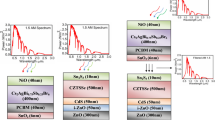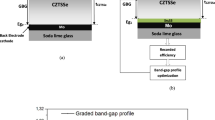Abstract
Kesterite Cu2ZnSn(SxSe1−x)4 has tunable band-gap values in the range 1 to 1.5 eV depending upon the Sulphur/Selenium stoichiometry. We analyze the proposed tandem configuration of kesterite absorber family using SCAPS-1D for device performance. Pure sulphide kesterite Cu2ZnSnS4 (CZTS) of bandgap 1.5 eV is utilized as top cell and a sulpho-selenide Cu2ZnSn(SxSe1−x)4 (CZTSSe) of band-gap 1.1 eV as the bottom cell stacked in a tandem configuration. We utilize the script file capability of SCAPS to simulate the effect of the presence of the top cell on the bottom cell; as the incident spectrum passes though the top cell, a portion of the incident spectrum is filtered out before it reaches the bottom cell. The condition of identical short circuit current (JSC) in the two cells in the tandem is attained by device optimization. We observe that a conservative estimate of two-junction tandem configuration of CZTS could achieve a minimum efficiency of 15%. This study brings out the device configuration of thin film CZTS/CZTSSe multi-junction for enhancing the efficiency of earth abundant CZTS based solar cells.



Similar content being viewed by others
References
Adewoyin, A.D., Olopade, M.A., Chendo, M.: Enhancement of the conversion efficiency of Cu2ZnSnS4 thin film solar cell through the optimization of some device parameters. Optik 133, 122–131 (2017)
Burgelman, M., Nollet, P., Degrave, S.: Modelling polycrystalline semiconductor solar cells. Thin Solid Films 361–362, 527–532 (2000)
Chen, S., Walsh, A., Yang, J., Gong, X.G., Sun, L., Yang, P., Chu, J., Wei, S.: Compositional dependence of structural and electronic properties of Cu2ZnSn(S, Se)4 alloys for thin film solar cells. Phys. Rev. B 83, 125201 (2011)
Hironiwa, D., Murata, M., Ashida, N., Tang, Z., Minemoto, T.: Simulation of optimum band-gap grading profile of Cu2ZnSn(S, Se)4 solar cells with different optical and defect properties. Jpn. J. Appl. Phys. 53, 071201 (2014)
Honsberg C. B., Barnett A. M.: Paths to ultra-high efficiency (>50% efficient) photovoltaic devices. In 20th European photovoltaic solar energy conference, 6 – 10 June 2005, Barcelona, Spain, 453–456 (2005)
Islam, M.T., Kumar, A., Thakur, A.K.: Defect density control using an intrinsic layer to enhance conversion efficiency in an optimized SnS solar cell. J. Elec. Mater. 50, 3603–3613 (2021)
Kim, K., Gwak, J., Ahn, S.K., Eo, Y., Park, J.H., Cho, J., Kang, M.G., Song, H., Yun, J.H.: Simulations of chalcopyrite/c-Si tandem cells using SCAPS-1D. Sol. Energy 145, 52–58 (2017)
Kumar, A.: Impact of selenium composition variation in CZTS solar cell. Optik 234, 166421 (2021)
Kumar, A.: Efficiency enhancement of CZTS solar cells using structural engineering. Superlattices Microstruct. 153, 106872 (2021)
Kumar, A.: Numerical modelling of ion-migration caused hysteresis in perovskite solar cells. Opt. Quant. Electron. 53, 166 (2021c)
Kumar, A., Ranjan, P.: Defects signature in VOC characterization of thin-film solar cells. Sol. Energy 220, 35–42 (2021)
Kumar, A., Thakur, A.D.: Design issues for optimum solar cell configuration. AIP Conf. Proc. 1953, 050022 (2018b). https://doi.org/10.1063/1.5032677
Kumar, A., Thakur, A.D.: Comprehensive loss modeling in Cu2ZnSnS4 solar cells. Curr. Appl. Phys. 19, 10 (2019)
Kumar, A., Ranjan, P.: Impact of light soaking on absorber and buffer layer in thin film solar cells. Appl. Phys. A 126, 397 (2020)
Kumar, A., Thakur, A.D.: Improvement of efficiency in CZTSSe solar cell by using back surface field. IOP Conf. Ser.: Mater. Sci. Eng. 360, 012027 (2018)
Kumar, A., Thakur, A.D.: Role of contact work function, back surface field, and conduction bandoffset in Cu2ZnSnS4 solar cell. Jpn. J. Appl. Phys. 57(S3), 08RC05 (2018)
Kumar, A., Thakur, A.D.: Impurity photovoltaic and split spectrum for efficiency gain in Cu2ZnSnS4 solar cell. Optik 238, 166783 (2021)
Leea, S., Priceb, K., Park, J.: Quantum efficiency modeling of thin film solar cells under biased conditions with a case study of CZTSSe solar cells. Thin Solid Films 619, 208–213 (2016)
Nishiwaki, S., Siebentritt, S., Walk, P., Ch. Lux-Steiner, M.: A stacked chalcopyrite thin-film tandem solar cell with 12 V open-circuit voltage. Prog. Photovolt: Res. Appl. 11, 243–248 (2003)
Patel, M., Ray, A.: Enhancement of output performance of Cu2ZnSnS4 thin film solar cells—a numerical simulation approach and comparison to experiments. Phys. B 407, 4391–4397 (2012)
Sameshima, T., Takenezawa, J., Hasumi, M., Koida, T., Kaneko, T., Karasawa, M., Kondo, M.: Multi junction solar cells stacked with transparent and conductive adhesive. Jpn. J. Appl. Phys. 50(5R), 052301 (2011)
Seyrling, S., Calnan, S., Bücheler, S., Hüpkes, J., Wenger, S., Brémaud, D., Zogg, H., Tiwari, A.N.: CuIn1−xGaxSe2 photovoltaic devices for tandem solar cell application. Thin Solid Films 517, 2411–2414 (2009)
Todorov, T., Gershon, T., Gunawan, O., Sturdevant, C., Guha, S.: Perovskite-kesterite monolithic tandem solar cells with high open-circuit voltage. Appl. Phys. Lett. 105, 173902 (2014)
Tung, V.C., Kim, J., Cote, L.J., Huang, J.: Sticky interconnect for solution-processed tandem solar cells. J. Am. Chem. Soc. 133, 9262–9265 (2011)
Vos, A.D.: Detailed balance limit of the efficiency of tandem solar cells. J. Phys. D: Appl. Phys. 13, 839 (1980)
Wadia, C., Paul Alivisatos, A., Kammen, D.M.: Materials availability expands the opportunity for large-scale photovoltaics deployment. Environ. Sci. Technol. 43(6), 2072–2077 (2009)
Wang, W., Winkler, M.T., Gunawan, O., Gokmen, T., Todorov, T.K., Zhu, Y., Mitzi, D.B.: Device characteristics of CZTSSe thin-film solar cells with 12.6% efficiency. Adv. Energy Mater. 4, 1301465 (2014)
Acknowledgements
Author heartly acknowledges Dr Marc Burgelman for providing SCAPS-1D software package.
Author information
Authors and Affiliations
Corresponding author
Ethics declarations
Conflict of interest
Authors declare no competing conflict of interest.
Additional information
Publisher's Note
Springer Nature remains neutral with regard to jurisdictional claims in published maps and institutional affiliations.
Rights and permissions
About this article
Cite this article
Kumar, A. Theoretical analysis of CZTS/CZTSSe tandem solar cell. Opt Quant Electron 53, 528 (2021). https://doi.org/10.1007/s11082-021-03183-5
Received:
Accepted:
Published:
DOI: https://doi.org/10.1007/s11082-021-03183-5




